By Molly Patrick
Jan 27, 2016,
By Molly Patrick
Jan 27, 2016,
Nutritionally speaking, if eating a vegan diet is a steamy kiss, then eating a Whole-Food Plant-Based diet is an exploding orgasm, followed by eating a perfectly ripe peach and then taking a catnap in the sun.
If the Vegan diet is having a friend you can laugh with, the Whole-Food Plant-Based diet is having a friend you can fart with.
If the Vegan diet is a two week vacation from the job that you hate, then the Whole-Food Plant-Based diet is telling your boss to fuck off, quitting your job, starting your own business and making a shit ton of money.
If the Vegan diet is listening to the WTF podcast, then the Whole-Food Plant-Based diet is being interviewed by Marc Maron in his garage. (#lifegoals #bucketlist)
There are lots of reasons why eating a Whole-Food Plant-Based diet (WFPB or Plant Based for short) is the most rock star way of healthy eating. One of the reasons for this is because people who stick to a WFPB diet don’t consume processed oil.
What oils can you use on a whole foods plant-based diet? Well, none.
People tend to get their panties in a twist over this. The no meat thing makes sense, the no dairy and no processed food bit is understandable, but the moment olive oil and, god-for-fucking-bid, coconut oil are taken out of the picture, people start to panic and wonder what the hell kind of cult they’ve joined.
And I get it, avoiding oil does seem pretty damn granola-ish, even for the Birkenstock wearing, VW bus driving, patchouli-smelling types.
When people are new to eating cucumber rounds instead of potato chips, beans instead of chicken, quinoa instead of white rice, and fruit instead of M&M’s, going one day without cheese is triumph enough – fuck trying to figure out how to avoid olive oil.
And there’s not a damn thing wrong with that. Everyone is on their own food journey.
It might take 6 months of eating Vegan hot dogs, Vegan cheese and Vegan ice cream before you feel comfortable having the majority of your meals made from ingredients found in the produce section.
It might take a year of thinking about cutting meat and dairy out of the diet before you take the plunge.
You might eat like a goddamn rabbit most of the time, but chocolate and wine are a different story and you’re not about to fuck with that story. That story is good for now.
It could be that you eat a plant rich diet and it never even occurred to you to cook without oil.
Wherever you’re at on your food journey is exactly where you’re supposed to be.
Just like anything in life, mastering the art of healthy eating is a series of piqued curiosity, experimentation, failing, learning, adapting and tweaking until it’s part of your routine and it fits you like your favorite pair of jeans. (The ones that make your butt look super hot)
When you’re ready to take your healthy eating to the next level, removing oil with a whole-food plant-based diet is the next thing to experiment with. Trust me, taking oil off from your shopping list is less of a cult thing and more of a genius move in your healthy eating journey.
Here’s why.
(this is way less complicated than putting together IKEA furniture – I promise)
The Whole-Food Plant-Based diet focuses on whole plant foods in their natural state or as close to their natural state as possible. The reason for this isn’t because plant based munchers are following a command given from our leader, Zelda, High Priestess of Chia.
The reason for this is because these are the foods that keep the body healthy, lean, energized and free of illness and common diseases like type 2 diabetes, as much as any food can.
Whole plant foods boost the immune system, they have anti inflammatory power, and they supply the body with huge amounts of antioxidants. It’s the chemical structure that make up whole plant foods that offer such powerful protection against harmful substances that cause cell damage.
So the reason why oil isn’t included in the WFPB diet is because all oil, even olive oil and coconut oil, are considered highly processed foods.
And this is because during the process of turning a whole plant food into oil form, for example olives into olive oil, the original structure of the plant is compromised and what’s left is a nutrient void, high fat, calorie dense ingredient with zero fiber and hardly a trace of the beneficial nutrients from the original whole plant food.
All oil is 100% fat and contains 120 calories and 14 grams of fat per tablespoon. That adds up fast, and since oil has zero fiber, the body absorbs it quickly and it is immediately converted into body fat.
As a rule, I don’t focus on the nutritional breakdown of calories, fat, carbohydrates, etc… of food because those numbers don’t tell the whole story of how nutritious a food is.
But I want to give a solid example of how nutrients and the structure of food changes, the more processed a food becomes, so today I will break my rule.
Let’s work this out with an example and take a look at sesame seeds.
1/4 cup of sesame seeds has:
213 calories
18 grams of fat
6.3 grams of fiber
6.3 grams of protein
And is rich in vitamins, minerals and phytochemicals.
Now let’s look at 1/4 cup of sesame oil.
1/4 cup of sesame oil has:
482 calories,
54.5 grams of fat
0 grams of fiber
0 grams of protein
And most of the original vitamins, minerals and phytochemicals are removed during the process of turning sesame seeds into sesame oil.
So eating sesame seeds is more beneficial for your beautiful bod than eating sesame oil, not only because they have a lighter fat and calorie load, but because sesame seeds have fiber, protein and lots of other nutrients – none of which can be said for sesame oil.
But hold the sesame boat, where does tahini (ground up sesame seeds) fit into all of this?
I’m glad you asked, Molly!
Tahini is considered a minimally processed food, and is A-okay to incorporate into the WFPB diet. This is because the nutrients and the fiber from the sesame seeds haven’t been lost in the process of grinding sesame seeds into sesame paste.
Let’s take a looksee.
1/4 cup of tahini has:
357 calories
32 grams of fat
5.6 grams of fiber
10.2 grams of protein (almost twice as much protein as the same amount of whole sesame seeds)
And unlike sesame oil, tahini is rich in the original vitamins, minerals and phytochemicals from the sesame seeds.
So, if you are ready and pumped to eat for your health, and especially if you want to lose weight, it’s important to eat the whole plant food instead of the oil version of that food. Eat olives instead of olive oil, sesame seeds instead of sesame oil, and coconut instead of coconut oil.
Are we good? Good. If you want to see for yourself how yummy food without oil is, our weekly Plant-Based Meal Plans never have a drop of oil.
Today’s recipe is simple, fast, hearty and yum. It’s almost as good as telling your boss to fuck off.
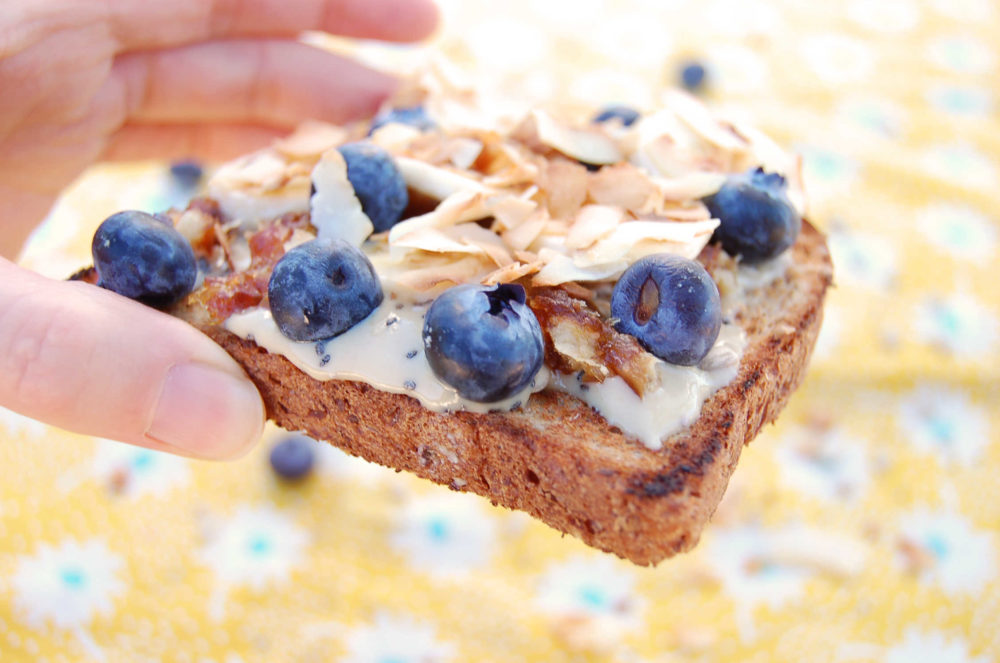
Ingredients
- Sprouted bread toasted
- Tahini
- Sunflower seeds
- Chia seeds
- Dried dates chopped
- Banana slices
- Blueberries
- Toasted Coconut
- Small squeeze of lemon
Instructions
- Toast your bread and then pile on the toppings.
- Add as much as you like of each ingredient and skip an ingredient if you don’t like it.
Notes
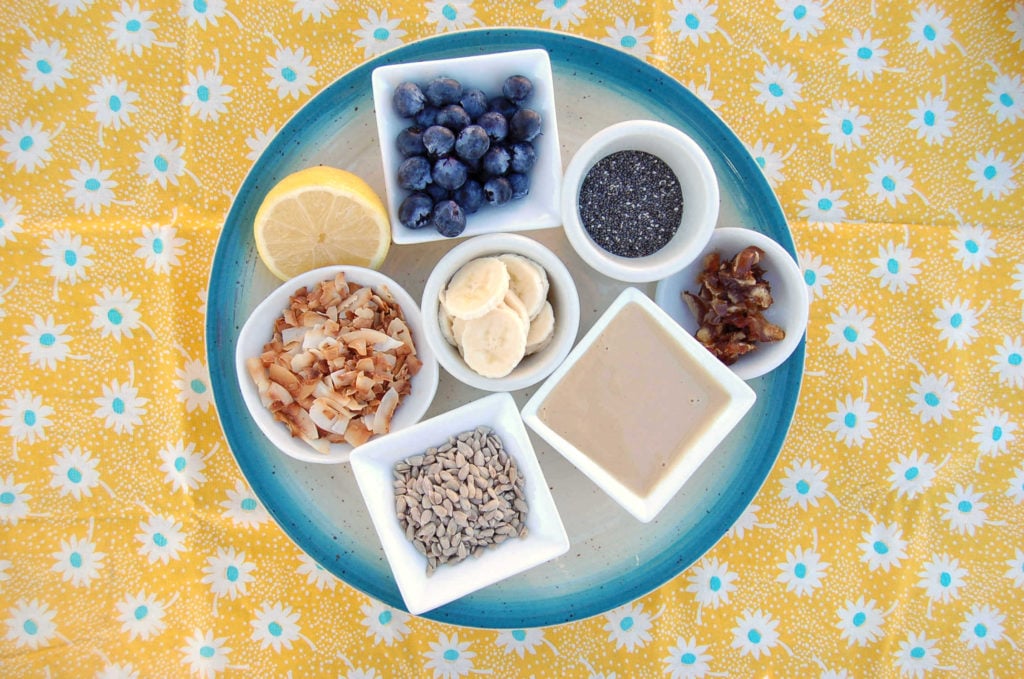
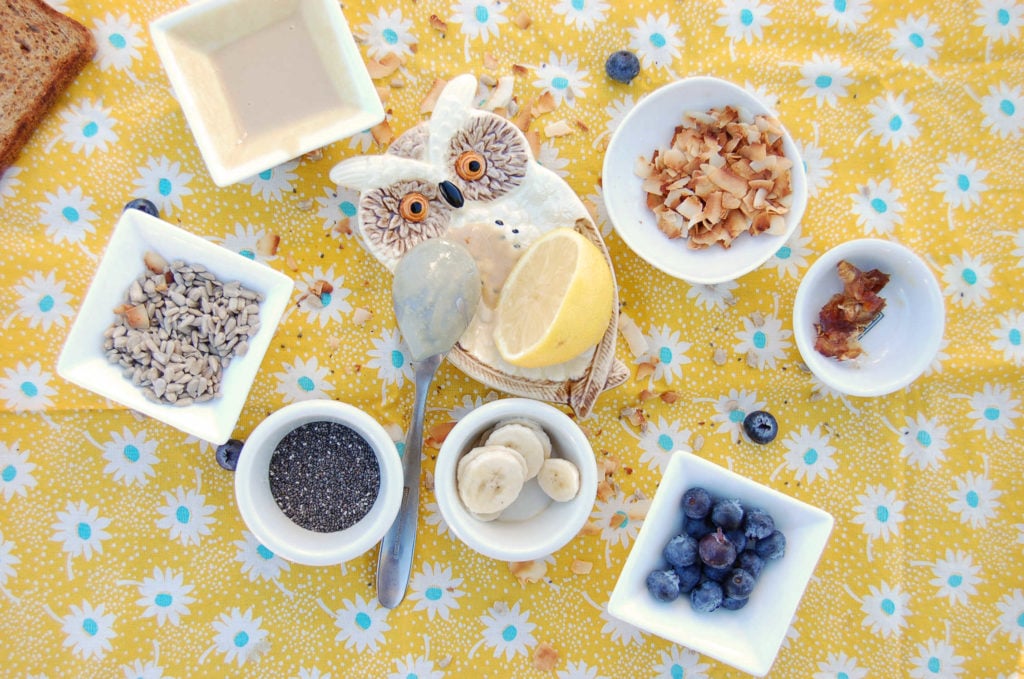
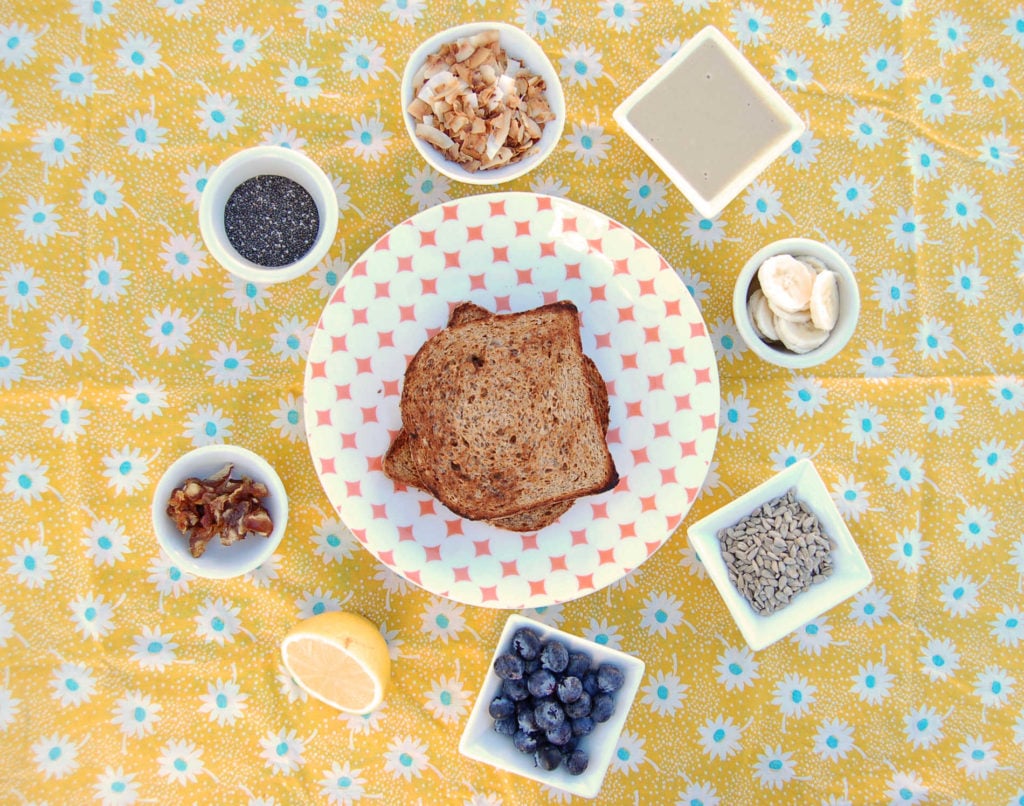
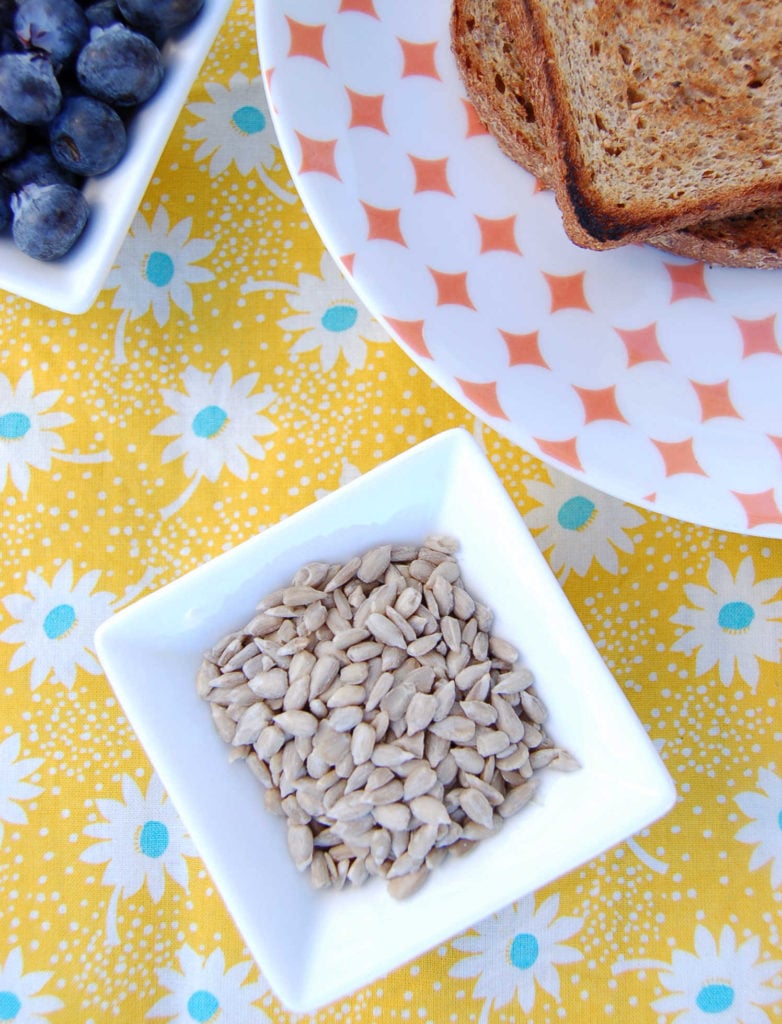
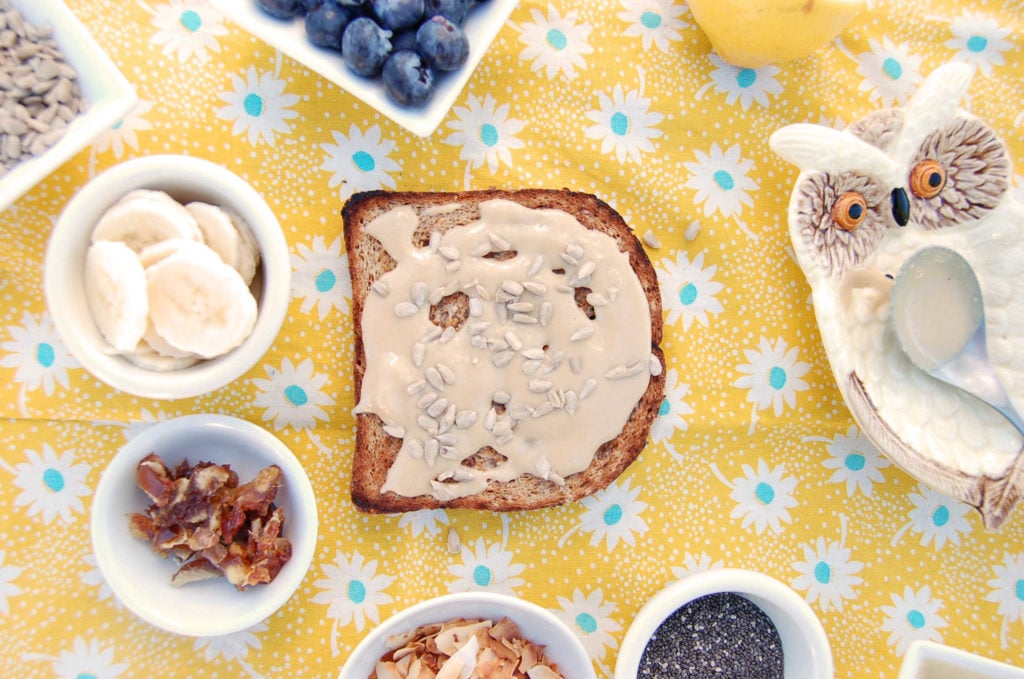
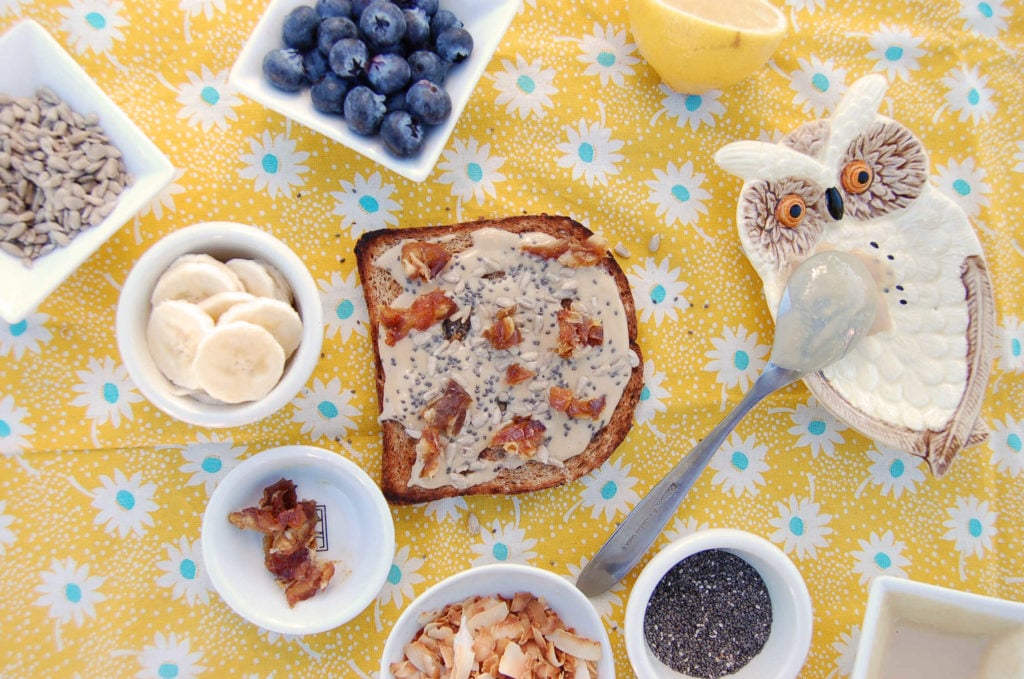
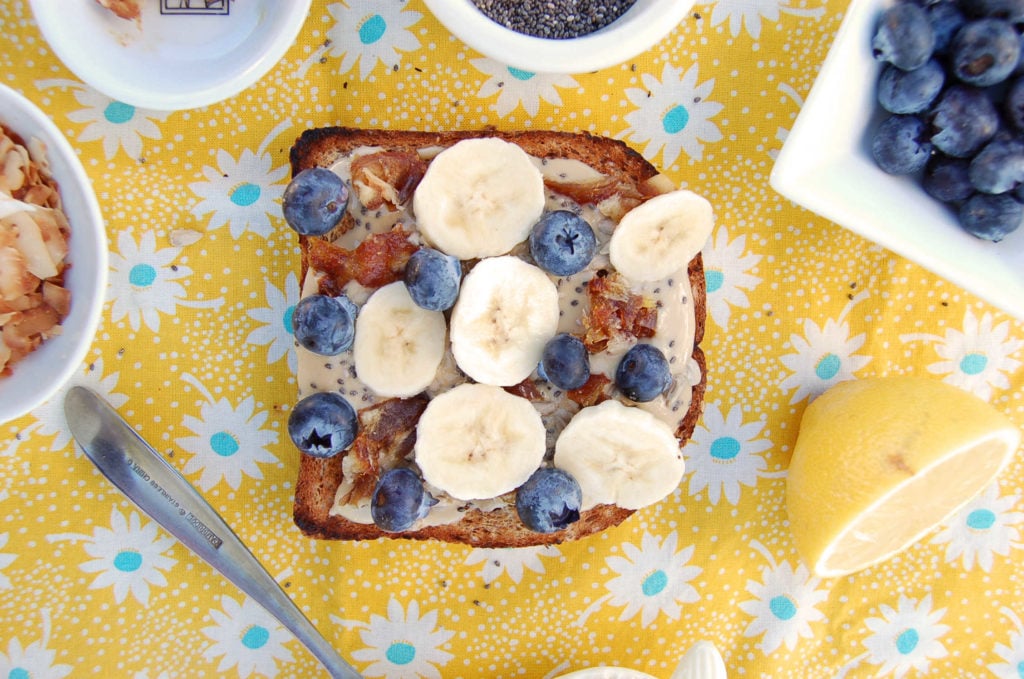
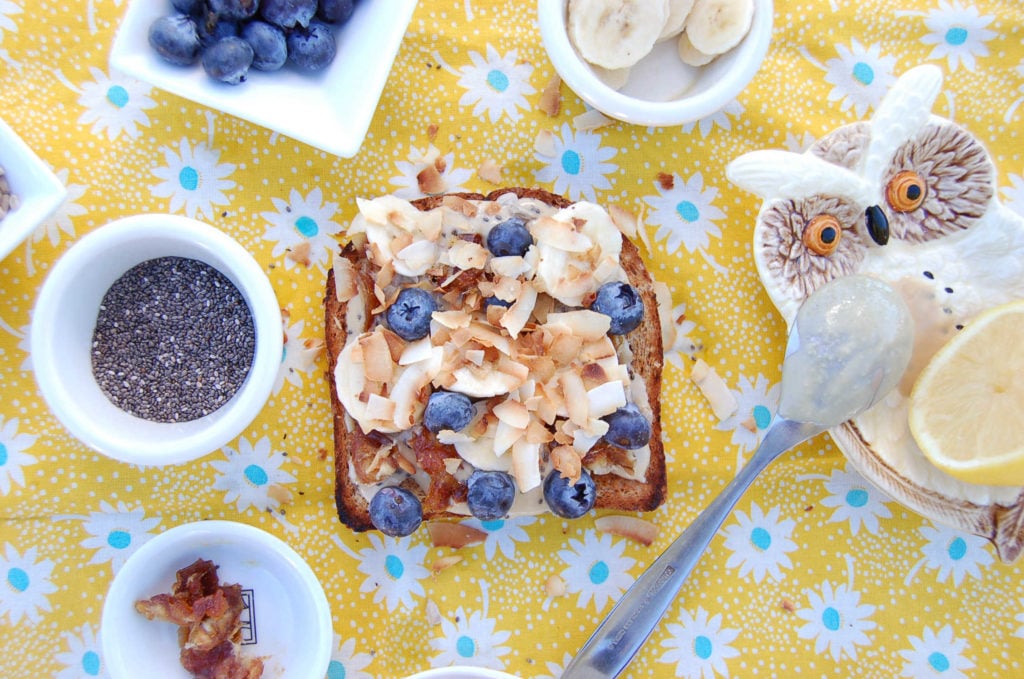



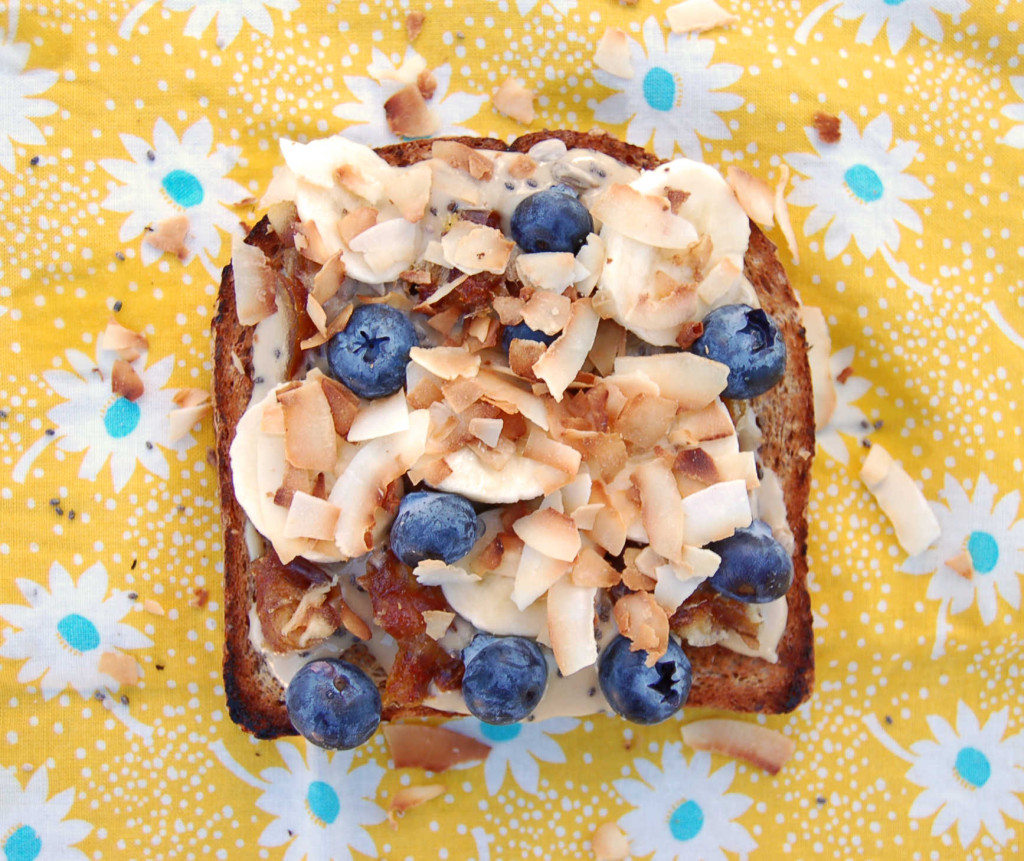

I hope that you have a happy week. May you look after your body as well as you look after your phone.
51 Comments
Leave a Comment
You may also enjoy...
Love the food that loves you back
Get instant access to thousands of plant-based recipes and meal plans, no credit card or perfection required.


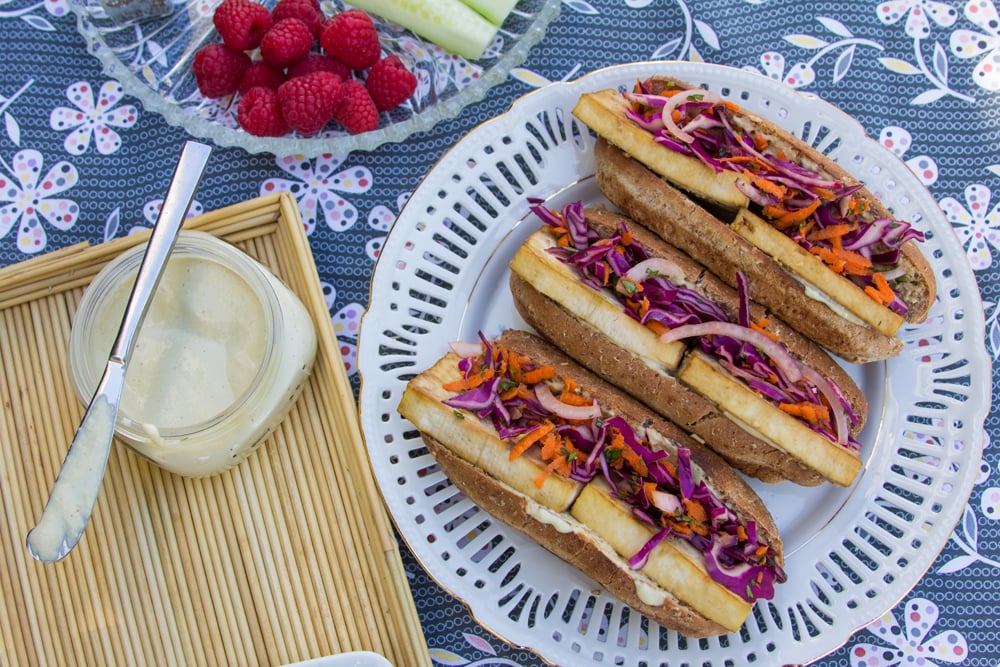


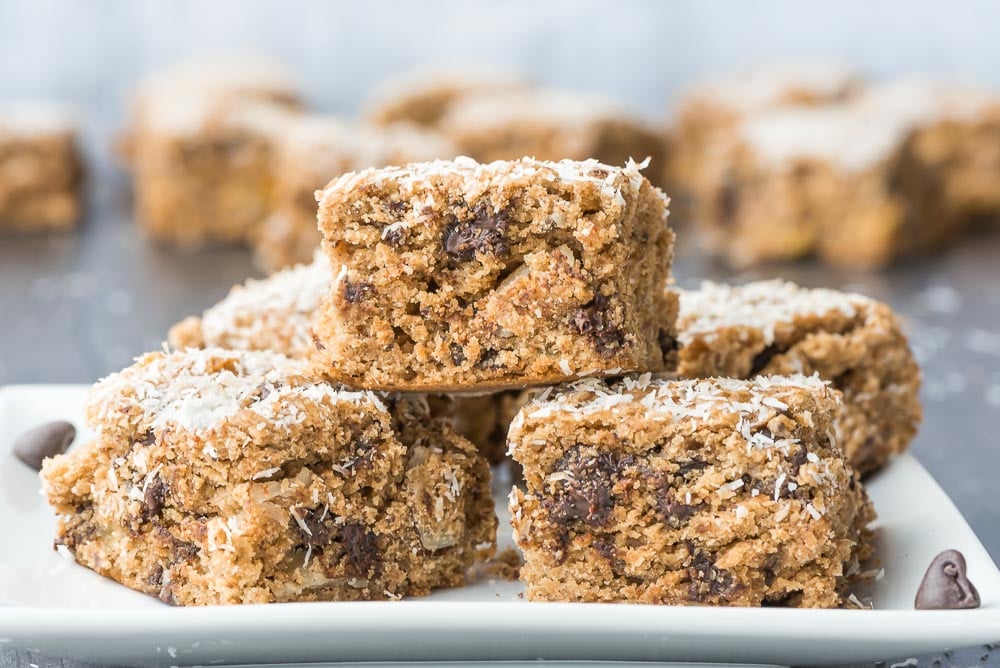








Wouldn’t bread fall under a “processed food” as well (and therefore try to avoid it)? Let me know what you think! Thanks. New viewer to the blog – I’ve already printed off MANY recipes!!
Hey Susan – not necessarily.
Here’s a recent post I did that has all of the minimally processed foods that are fine to incorporate into a Whole Food Plant Based diet.
Truly whole wheat and sprouted grain bread are just fine.
https://cleanfooddirtygirl.com/list-of-whole-food-plant-based-ingredients-roasted-kabocha-squash/
So glad you’re liking my recipes!
xo
Molly
Hi Molly,
I have started eating a whole foods, plant based diet, and I am on my fifth week (but who’s counting, right?) now. I started with a WFPB diet at first instead of just going vegan, because it made the most sense to me. I have known people who are ‘vegan’, but they still eat like crap.
I came across your site when looking for whole foods, plant based recipes, because I need great recipes for healthy food, but I also want to avoid all of the vegan processed foods like the imitation cheese, butter, and other stuff that is just no good to me. That search has narrowed down the results quite a bit, but I was happy to see your site and recipes.
I will definitely be looking at more of your recipes and articles in the near future, so thanks in advance! By the way, the fancy toast looks amazing and you have excellent photos. I will let you know if I try it out for myself.
Hey Cassie,
Congratulations!
If you haven’t joined our private Facebook yet – come on over!
It is the best group of people evah!
xo
Molly
Hi Molly,
Thank you for inviting me! I would love to join, but I do not have an account on Facebook anymore. 🙁
Got it!
You can still join the action by signing up for my Saturday emails 🙂
Here’s the link:
https://cleanfooddirtygirl.com/signup/
xo
Molly
Molly,
I just signed up, so I’m way ahead of you. 🙂
You will probably be hearing from me as I read more of your articles and recipes (while I’m at work today, but don’t tell anyone).
Have a great weekend!
I’m in awe! You addressed every question I had, in a pretty minimal time even on your site, and with humor and super clarity!
Thank you!!!
You are most welcome!
xo
Molly
Full disclosure,
I’m pretty triggered that you’re recommending us to eat toast while advocating against oil 🙁
One can be full of good triglycerides and antioxidants (albeit low in original nutritients) and is always on my shopping list for daily oil-pulling, while the other is inflammatory, gut-wall-lining-tearing, fungus feeding, just… feel me here, very frustrating to read this post.
Mush love though.
Hi Ryan, thanks for stopping by. On the scale of processed foods, sprouted bread is pretty low on the scale of processing and it retains its fiber and nutrients which are important to eating a whole food plant based dietary pattern. While I’m not well-versed on the chemical composition of breads, I’m guessing that you are referring to gluten as being “inflammatory, gut-wall-lining-tearing, fungus feeding”. People with celiac should absolutely avoid gluten containing breads as should those with gluten sensitivities but by and large, most people thrive when including nutrient-dense sprouted grain bread in their diet. AND, sprouted breads are naturally lower in gluten. This company produces sprouted breads and they actually had their sprouted bread tested. Under one of the FAQ questions at that link they write: “the typical profile for a wheat based bread is 10,000 ppm and, depending on the product, can spike as high as 75,000 ppm” and “We had our bread tested by a laboratory that tests for gluten. Their analysis came back with a gluten profile of 81 parts per million. According to the FDA, the threshold for “gluten-free” is 20 ppm which means anything that has 20 ppm or less gluten can be considered “gluten-free.” So even though sprouted bread is not technically gluten-free, it’s pretty darn close…at least for this company’s product.
As far as oil goes, if you like to have oil in your food, go for it. Even all of us here at CFDG occasionally have oils in our food eating out because it’s pretty much impossible to avoid them. It’s just that the prevailing thought in the world of WFPB is that oils aren’t necessary, are likely damaging to the endothelial lining of the vascular system, and add calories with not much else and that’s why our meal plans use no added oil. Molly used to oil pull as well, but switched to water after this 4-part series beginning with this video was published late last year. ~Karen
Hello! We are just starting the WFPB diet and I think I even have my husband on board, but I know I will have to do most of the work. I’m ready to get recipes and do the complete switch for our health!
Thank you for your work–if it weren’t for people like you, I wouldn’t know how to go about this new way of life!!
Hi Dawn,
Welcome to the Dirty Girl club! If you haven’t already, please join our hilarious, supportive, kick-ass Facebook group and check out Dirty Girl membership, which includes weekly plant fueled meal plans, an accountability partner, monthly training with Molly, $150 off the Plant Based Reset, merchandise discounts and more!
xo
Meghann
Team Dirty Girl
seems really informative but is it necessary to add the swear words?
you seem well educated and well versed on your writing so it seems to make no sense to me.
but very good job and thanks for all the insight on the WFPB diet.
i do believe this is an excellent way in helping ones body mind and SPIRIT
Swear words unnecessary but definitely add a little fun to the posts. I’m a fan!
AGREED!!! Too many swear words for me too! I’m sold on this diet and information was good especially for me to check out the podcast. I am new to this and have a lot to learn. Thank you!
what if you can make your own coconut oil, is it still bad. Same with sesame oil…
Hi Raj, making your own oils would likely be healthier than store bought, but eating the whole coconut or olives would be even healthier. 😉
xo
Meghann
Team Dirty Girl
Cool, thanks it makes sense. The challenge with Indian food is to do seasoning we have to use 2 tsp of oil. If not the taste changes completely. That is what I am struggling with ?
I’m a newbie to WFPB eating. My motto is “everything in moderation.” If you need 2 tbs of oil for an otherwise healthy recipe to work, then do it.
No, this is terrible advice. You need to change your tastes to appreciate healthy food. You are addicted to fat. YES not adding oil to a recipe changes the taste and you need to learn to appreciate the taste of food that doesn’t have oil in it.
Funny and informtive… Perfect!
What are your thoughts on Almond Butter? I’ve been spreading that on Sprouted Bread and adding berries and eating it for breakfast since I began my WFPB journey. Do I have to give that up or is almond butter ok?
Thanks, LOVE your recipes. Just signed up for meals plans, batched yesterday, and am excited for dinner tonight!
Beth we LOVE almond butter. No way do you have to give it up. Just make sure the only ingredients in it are almonds (no added sugar, salt, oil oils)
Please get informed about extra virgin olive oil. First of all, a fresh high quality olive oil is not 100% fat and contains 2-3% of incredibly healthy antioxidants, some of which you can not find in any other fruit. Second, olive oil is NOT processed but mechanically extracted and retainsa small but very important of the nutrients contained in a green olive. And if you think the table olives you find in the store have more nutrients than extra virgin olive oil, you are plain wrong. So, the only way to get some of the nutrients contained in a green olive is indeed to consume extra virgin olive oil. Third, there are numerous health claims that the European Union allows for high quality extra virgin olive oil, main reacted to the phenolic content, including preventive qualities against Alzheimer, cancer and more… and as you kniw, Europeans tend to be anti capitalist socialists with no powerful food lobbies, so those claims are more credible than if they were made by the FDA.
Aside from that, I am all in for a mainly plant based diet, even though I would be more relaxed about eliminating entirely anything, moderation is much better, something that we should promote more in USA, learning from our European friends on life style.
Hi Daniele,
Thanks for checking out the blog. As Molly mentions in the blog, once the fiber is removed, the resulting product is processed, whether it’s olives, coconut, or sesame seeds. High quality olive oil may retain some phenolic content, but with the fiber removed, it’s still processed because it’s not in its whole plant form. One of the tenets of a whole food plant based diet is maximizing consumption of whole plant foods. Here at CFDG, we’re not super sticklers, though, and think that if you prefer to consume extra virgin olive oil, by all means, enjoy. I’ll still have it if I know it’s good quality and I am limiting the amount (usually it’s in an herb paste that I get at my local coffee shop) but after eating wfpb for a long time, I have found that I truly dislike the mouthfeel of straight up oils – olive or otherwise. Restaurants here in the US tend to go overboard with fats in this way to begin with. Certainly, it’s better than solid fats and other oils. Nevertheless, at this time there is evidence in the medical literature showing that even the best olive oil is not helpful to vascular health. And, in the PREDIMED study, the results showed that while olive oil consuming participants reduced strokes by 1/3 (which is good!), those eating whole nuts instead reduced their stroked by 1/2 (which is even better!).
Karen
Team Dirty Girl
You advocate no processed foods even ones that are good for you (EVOO hemp seed oil etc.) but bread is ok, which is a processed food. I mean talk about lmao. Do you know what happened to your precious Whole Foods when you bake them even without oil? They undergo significant chemical and physical changes which is what you are supposedly trying to avoid. Just because it has fiber makes it good? 🤔 And don’t give me this it’s less processed crap, please…
Hiya!
We eat minimally processed foods like tofu, tempeh, and yep, whole grain flours and breads. Oil isn’t considered a whole food because, even though some of it is minimally processed, it’s been stripped of almost all nutrients and fiber. Your body needs fat, but avocados, nuts, and seeds are better sources as they also contain nutritional value. The packaged nutrients and fiber help support healthy functions.
Whole food plant based eating isn’t a raw diet, many foods are cooked before eating, which changes them to make many nutrients more bio-available. The focus is instead on whole foods. White bread would not be considered a whole food because, like white rice, the flour has been processed to remove vital nutritional content. We suggest buying bread made from whole or sprouted grains, with no added sugar or oil.
This all being said, we always advocate for people doing what works for them. If you prefer to use oil and avoid bread, that’s fine with us and we wish you well. 🙂
Thanks Karen. I appreciate your response and I will look into the materials. I am a big consumer of nuts, olive oil and whole food products, so I hopefully get a triple benefits. I add olive oil to all my veggies and salads, but that’s just me due to my Italian/Tuscan heritage. I agree that if you don’t get a fresh/good olive oil, you are better off going with something else. And I know hoe tough it can be to find a good/authentic product in grocery stores. Regards, Daniel
About olive oil, it is very difficult to know if you you are getting the real thing or a product full of substitutes?
Hi FT,
I’m not sure if there’s a foolproof way to know if you’re getting the real deal when it comes to olive oil, but I have heard that there are a lot of imposters out there. You could Google it and get some opinions on which brands are more reputable, or you can try going without oil for a bit and see how you feel without it in your diet. I CAN tell you that it makes doing the dishes much, much quicker and easier! 😉
xo
Meghann
Team Dirty Girl
Oh joy of joys….I posted something today about oils being processed and got the titans raining down on me! I won’t repost or share the link but the info is so entertaiingly well put. I shall so enjoy reading more. I’m currently studying the WFPB Nutrition Course by Colin T Campbell. Lucky me!
Hi Stephanie, Thanks for stopping by and commenting. Molly has many more entertaining posts that we hope you’ll enjoy. All the best to you in your course!
Karen
Team Dirty Girl
Hi, Thanks for sharing the info. What do you use to cook with if not oil? Stir-fry veggies? Do you just bake everything dry? Thanks! Kristin
Hi Kristin! The technique is to preheat your pan for a couple of minutes before adding your veggies. If things start to stick during cooking add a splash of water or broth, depending upon the recipe. For baking, baking mats or parchment paper work great. ~Karen
Awesome – thank you!
True story: When I lived on Crete, my landlord was the owner of a small olive oil “manufacturing” facility. I went with him one day to watch (I love/d EVOO and wanted to see the process). The thing is, the volume of olives going into the machine did not produce anywhere NEAR the same volume of oil, so I would think that the 1/4 cup of sesame seeds in the example in this post is not a fair comparison with a 1/4 cup of sesame seed oil.
That being said, I do see thy point. Call me a stubborn old coot, but I don’t think I’ll ever be to the point where I give up my EVOO and sessie oil, although I will be cutting down drastically.
I tried the vegan route for a while but they’re just such judgmental a-holes! The splitting of hairs is a sport for these peeps! I say this because, for the reason above (about the oil) and also the fact that, since I am (deathly) allergic to mushrooms, for any recipe I find on a WFPB website, I will be using seitan (GAH!!)”coins” instead, so hopefully I won’t have “HERETIC!!!!” flung my way too often by the WFPB community. 🙂
Hi Dmitri, thanks for stopping by and sharing your perspective! For sure, a higher volume of sesame seeds was required to make the equivalent cup of oil. The main takeaway is that oil is so much more calorie dense because the other nutrients are stripped away leaving (pretty much) only the fat to fulfill the volume. If you enjoy EVOO and sesame oil then keep them in your dietary pattern. Even though our meal plan recipes don’t contain oils, life is challenging enough and it’s not healthy to bring yourself stress over eating occasional oils, whether at home or in a restaurant – particularly if you are eating lots of whole plant foods most of the time. You might enjoy reading Molly’s take on judgmental vegans here. ~Karen
Once I realized that dry or water sauteeing really does work, my oil use just about disappeared……except for my roasted veggies. I mean how was I supposed to keep the seasonings on the pieces??? Then I hit on the perfect compromise: olive paste! just chuck some olives into the food processor and toss the veggie chunks with the paste and season and roast away!
I’m going to try this, thanks! I just roasted my veggies with some EVOO. I love my roasted veggies. What olives did you use? Seedless kalamata was what I was thinking.
You have a filthy mouth. Just saying.
As someone who is new to this way of eating, I find the culture very off-putting. This is a hard transition, and all the crunchy, feel good, love yourself, dharma-speak is very hard to get past. When you’re trying to change a lifetime of comfortable habits, it doesn’t take much to think, “Well, I guess this isn’t for me after all!” So anything that makes this relatable and human is very welcome, and that includes the occasional F bomb. So maybe, instead of chiding people for expressing themselves in ways that don’t speak to you, consider that it may be exactly the language that someone else needs to hear to feel welcome. Namaste, motherfucker.
hahahaha! That is awesome!
I’m not a prude but I couldn’t read this article about clean eating when it’s so full of profanity. Toxic words are worse than toxic food. What’s the point in being WFPB if your language is that of junk food?
You are in luck! There are literally thousands of other blogs out there about clean eating!
Hooray for the internet and diversity of language.
Lots of love headed your way!
xo
Molly
Why people get wound up about your language is beyond me. If you’re here for WFPB eating and your health it would seem language would be the least of your worries, provided the info was good. There are bigger things to worry about for fucks sake.
I absolutely loved this article. I just signed up for the newsletter as well. Just yesterday I was enlightened regarding removing oil from my diet after being meat and dairy free for over 3 months. I thought “Something else?! Maybe I should just suck on ice cubes all day!” Your take on the food journey is encouraging and helpful I’m on y way to check out your article on cooking without oil! Thanks for what you do!
Thanks for stoppying by, Mandy! Welcome to our community! There are so many delicious oil-free recipes on the blog. Also, we have a free Trial meal plan (#Trial) that gives access to our new classroom and all its features – including recipe scaling. #Trial doesn’t expire – so if you request it and just aren’t ready to tackle a full meal plan yet, you can come back when you are. And, requesting #Trial does not automatically convert over to a paying subscription, so there is absolutely no risk to request it. The link to request it is here (look for Unlock Access on the grey ribbon). ~Karen
Your use of profanity is not appreciated!
Hi Stan, Molly realizes that her writing is not for everyone and that’s ok with her. She has written about why it’s important to her that she writes in her own voice (heads up there is profanity so you probably won’t want to read it). There are so many other whole food plant based resources on the web, we’re sure you will find something that is suitable for you. ~Karen
Nuts, seeds, nut butters, and tahini are all really high in fat and should only be used in moderation. Most people are addicted to fat and it has warped their palate so that anything that is not high in fat tastes bland. The easy solution to this when going “whole food plant based” is to just add a bunch of tahini, peanut butter, coconut milk, avocado or a cup of blended cashews to every recipe so that it’s palatable. But this doesn’t really fix the problem. The problems is people are addicted to fat and a high fat vegan diet, or a high fat whole food plant based diet, although slightly better than a standard american diet, is just kicking the can down the road.